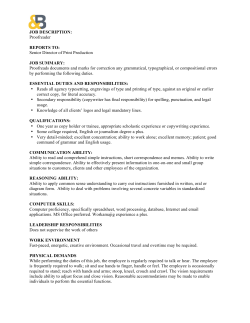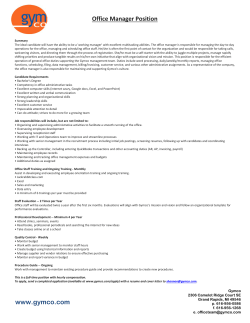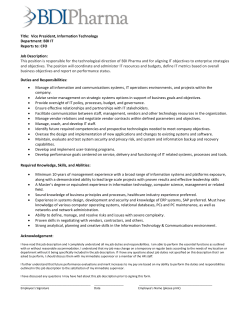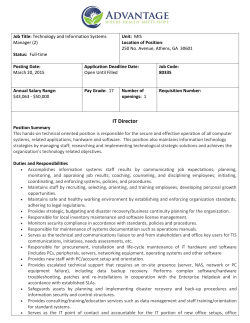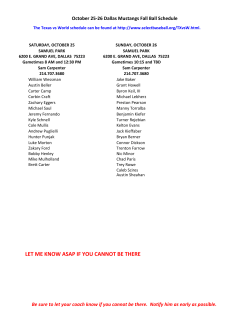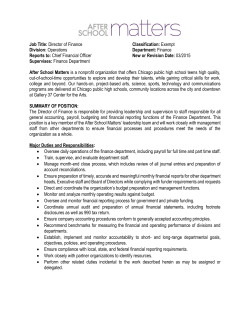
Carpenters - James Marine
James Marine Carpenter Functional Job Description ESSENTIAL FUNCTIONS: 1. 2. 3. 4. 5. 6. Carpenter must be able to perform framing, finish carpentry, and hang doors. Carpenter must be able to load and unload materials and tools to and from the worksite. Carpenter must maintain records of daily activities and prepare routine reports. Carpenter must be able to hang, finish, and repair drywall. Carpenter must be proficient with power tools and power saws. Carpenter must be able to keep a clean and organized workspace. PHYSICAL DEMANDS OF JOB: Never 0% of an 8 hour day 0 hours Material Handling Non-Material Handling Occasional 1-33% of an 8 hour day ≤ 2.6 hours 1-32 repetitions/day 1-100 repetitions/day Frequent 34-66% of an 8 hour day ≥ 2.7 hrs - ≤ 5.2 hrs 33-200 repetitions/day 101–800 repetitions/day Constant 67-100% of an 8 hour day ≥ 5.3 hours > 200 repetitions/day > 800 repetitions/day Standing: (Constant) Carpenter must be able to stand to complete various duties associated with essential job functions such as carpentry work, loading/unloading of materials, drywall work, cleaning duties. Walking: (Frequent) Carpenter must be able to walk to complete various duties associated with essential job functions such as carpentry work, loading/unloading of materials, drywall work, cleaning duties. Sitting: (Never) Lifting: (Frequent) Carpenter must be able to lift materials weighing up to 50 pounds from floor to shoulder height of up to 60 inches. Carrying: (Frequent) Carpenter must be able to complete side and/or front carries consisting of steel and aluminum materials weighing up to 50 pounds for distances of up to 50 feet. Pushing/Pulling: (Frequent) Carpenter must be able to generate push and pull forces of ≥100 pounds to complete various tasks such as carpentry work, loading/unloading of materials, drywall work, cleaning duties. Forward Bending: (Frequent) Carpenter must be able to attain/maintain a forward flexed position of up to 60 degrees to complete various duties associated with essential job functions such as carpentry work, loading/unloading of materials, drywall work, cleaning duties. Trunk Rotation: (Frequent) Carpenter must be able to rotate their trunk/torso left-right to complete various tasks associated with essential job functions such as carpentry work, loading/unloading of materials, drywall work, cleaning duties. FJD; James Marine, Carpenter Reaching: (Frequent) Carpenter must be able to forward reach to a shoulder level height of between 48-60 inches to complete various duties associated with essential job functions such as carpentry work, loading/unloading of materials, drywall work, cleaning duties. Manipulating/Handling/Gripping: (Frequent) Carpenter must be able to complete gripping, pinching and manipulation of various parts and pieces of equipment utilized for the performance of essential job functions. A grip force of ≥ 80 pounds is necessary for the completion of tasks. Climbing: (Occasional) Carpenter must be able to ascend/descend steps and /or equipment varying from 7 – 12 inches in step heights to complete various duties associated with essential job functions such as carpentry work, loading/unloading of materials, drywall work, cleaning duties. Kneeling: (Occasional) Carpenter must be able to kneel to complete various duties associated with essential job functions such as carpentry work, loading/unloading of materials, drywall work, cleaning duties. Crouching: (Occasional) Carpenter must be able to crouch to complete various duties associated with essential job functions such as carpentry work, loading/unloading of materials, drywall work, cleaning duties. Crawling: (Never) Squatting: (Occasional) Carpenter must be able to squat to complete various duties associated with essential job functions such as carpentry work, loading/unloading of materials, drywall work, cleaning duties. Postural Balancing: (Constant) Carpenter must be able to maintain both static and dynamic while ascending/descending equipment, stairs and/or ladders to complete various duties associated with essential job functions such as carpentry work, loading/unloading of materials, drywall work, cleaning duties. WORK LEVEL: Heavy Work (Level 4) as defined by the Dictionary of Occupational Titles. Occasional Frequent Constant Sedentary (1) ≤ 10 lbs. Negligible Light (2) ≤ 20 lbs. ≤ 10 lbs. Medium (3) ≤ 50 lbs. ≤ 25 lbs. ≤ 10 lbs Heavy (4) ≤ 100 lbs. ≤ 50 lbs. ≤ 20 lbs. Very Heavy (5) > 100 lbs. > 50 lbs. > 20 lbs SIGNIFICANT WORKSITE MEASUREMENTS: Tools: Materials: Steps/Ladders: weighing up to 10 pounds. weighing up to 50 pounds. up to 7-12-inch step/rung heights. TOOLS/EQUIPMENT USED TO PERFORM JOB: Power tools, power saws, hand tools, sledgehammer, tape measure May 2012 (Evaluator Jase Pinerola, PT, DPT, Kevin Winn, CSCS; Employee Rick Henson)
© Copyright 2025
